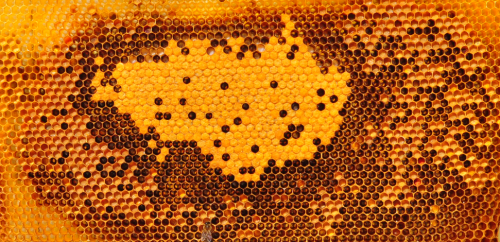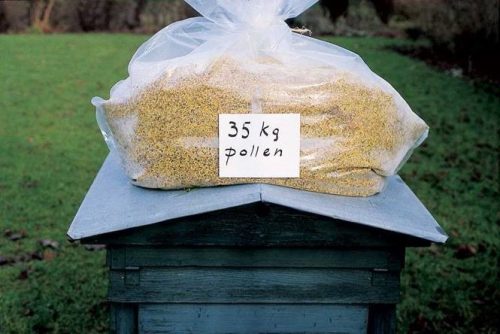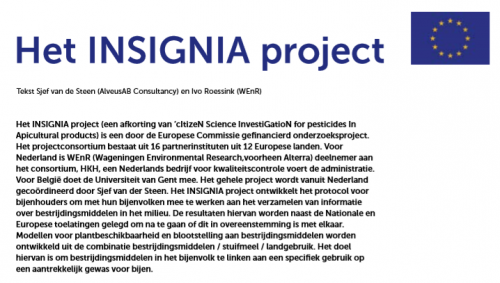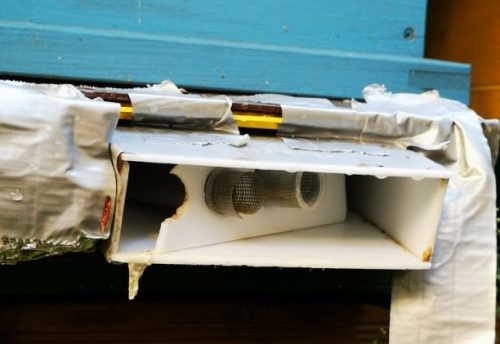
In Flemming V’s blog of last week, 35 kg pollen was mentioned as the amount a colony collects. Is this realistic, too much or too few? Continue reading “How much pollen does a colony need?”

PREPARATORY ACTION FOR MONITORING OF ENVIRONMENTAL POLLUTION USING HONEY BEES

In Flemming V’s blog of last week, 35 kg pollen was mentioned as the amount a colony collects. Is this realistic, too much or too few? Continue reading “How much pollen does a colony need?”
Do bee colonies make pollen stores? Yes, they do!

One of our old very valued scientists in Denmark Orla Svendsen long time ago made the nice picture with a big pollen bag on the roof of a bee colony to illustrate the consumption/need of pollen as protein supply for a production honeybee colony. Literature claim different values, but he claimed a colony needs around 35 kg a year. Sjef van der Steen (personal comments) did some very nice calculations on this subject that does support this saying 30-35 kg. This is a lot. Continue reading “35 kg of pollen per year”
Sjef van der Steen
To inform the Dutch beekeepers about the Insignia pilot study, an introduction in the Insignia pilot study” was published in Bijenhouden, the monthly journal of the Dutch Beekeepers Organisation (NBV).

written by Marco Pietropaoli, Giovanni Formato, INSIGNIA Consortium
For the INSIGNIA project (“Environmental monitoring of pesticide use through honey bees” PP-1-1-2018) (https://www.insignia-bee.eu) our laboratory in parallel with other project partners from Denmark (Danish Beekeepers Association), Netherlands (Stichting Wageningen Research) and Latvia (Latvian Beekeepers Association) is carrying out a small field trial to check the relation between colony size and forage activity in order to calculate the exposome.
How to count honey bees flying out of the hive? Thanks to Beecounters!
They are light plastic boxes with a micro-processor powered with a 12V current (Figure 1). Just put them at the hive entrance, power on and that’s it!

The colours of pollen do much the RAINBOW! Different plants, different pollen grains, different colour of pollen and aromas, this is the paradise of bees’ life! But it is not only the beauty in the colours of pollen as you see in this combination picture.

The more colourful your pollen is, the more nutritious it is! and this has been proven many years ago. Of cource there are exceptions and there are some plants that can be very very nutritious alone, as the Rubus sp. for example, but usually mixed pollen is better for the bees health as well as for humans. I suspect that you eat pollen, right? Think that 2 teaspoons of pollen and 1 teaspoon of honey every morning can give you the energy you need for the whole day!
Fani Hatjina
On our way to meet the Citizen Scientist we pass from Volos (see previous post), where we saw this beautiful ancinet ship ‘ARGO’. Maybe, the treasure for ancient Jason and his Argonauts was the Golden Fleece (kept in Colchis by the father of Medea) but for us it was the pollen and bee bread samples colelcted for 5 weeks by the Citizen Scientists. And for sure we did not travel to collect them by ‘ARGO’ as Jason did during the mythical times! Ouaou, isn’t the right moment to say that Science meets History?

Back to the laboratory though the next day, it took us several hours to separate and register the samples, as well as to prepare them to be sent to the analytical laboratory. Laborious task indeed but pleasant, as you can see 1, what samples the CS collected at every time point; 2, the way the samples were stored and prepared; and 3, how much effort is required to have these samples ready for analysis! Colours of pollen so different! We just hope the results will be great and informative!


Fani Hatjina
All samples collected by our citizen scientists have to go through the hands of each country’s national coordinator prior to shipping them to the corresponding labs in Greece, Spain and Portugal. The national coordinator checks the information on the sample bags (sample ID, the sample date and the bee colony from which the sample stems from) and compares it to our backup system (LimeSurvey answers). Afterwards, the sample processing takes place as it was described in a previous post: https://www.insignia-bee.eu/samples-in-the-laboratory/#more-599


Kristina Gratzer
Our citizen scientists were asked to sample some honey of their last honey harvest to compare the results to those of the pollen analyses. An alternative option was to cut out about 5 x 5 cm pieces of the honey combs. Latter has the advantage of not only honey, but also beeswax samples. Analyzing beeswax and honey are also common matrices to learn more about pesticide residues or pollen sources. Let’s see, what we will find out.

Kristina Gratzer
The samples on the picture came from a very reliable and motivated citizen scientist (CS) but during the checking process of samples through the national coordinator, we recognized that the used pen got blurred during sample transportation. Miss-matching samples are a catastrophe for the labs and the future results! This is the reason, why it is so important to have a backup system and to stay in close contact with the citizen scientists. Within the INSIGNIA project, every CS answers an online LimeSurvey questionnaire after each sampling date dealing with sample IDs, the date of the sample collection, phenology, possible problems, colony strength etc… With the help of this system, it was possible to assign each sample the right sample ID, bee colony and the right sample date.
Nevertheless: CHOOSE THE RIGHT PEN- which is always a PENCIL!! 🙂

Kristina Gratzer
According to Murphy’s law “whatever can go wrong, will go wrong” or in this case, “whatever can break down, will break down”. Last week we had some thunderstorms in Graz (Austria). The stormy weather was the reason, why we were surprised by an adapter, that was ripped in several pieces, the next morning. As the “outside tubes” were also gone, we had to insert new ones. Luckily and thanks to Duck tape, the broken adapter could be fixed and mounted very quickly.


Kristina Gratzer